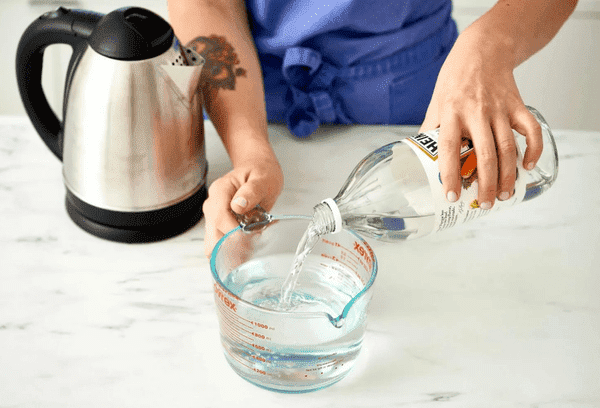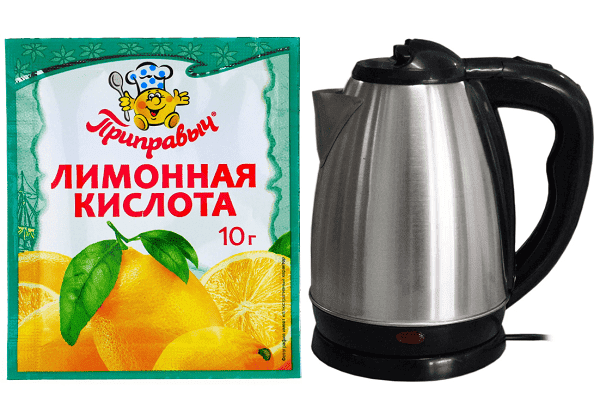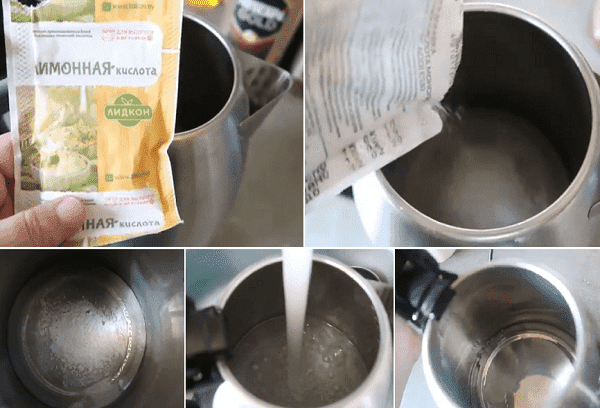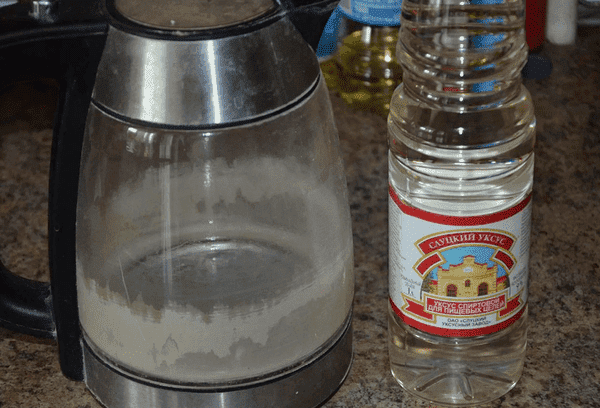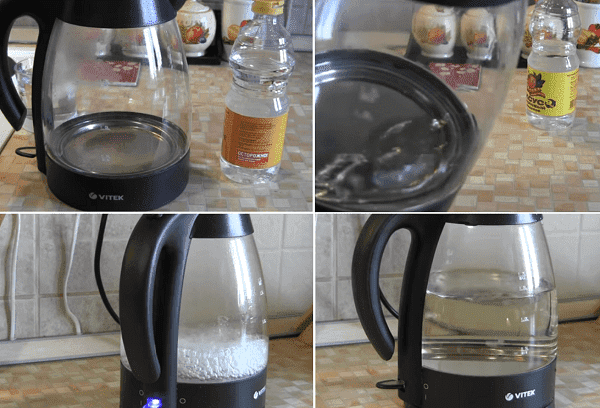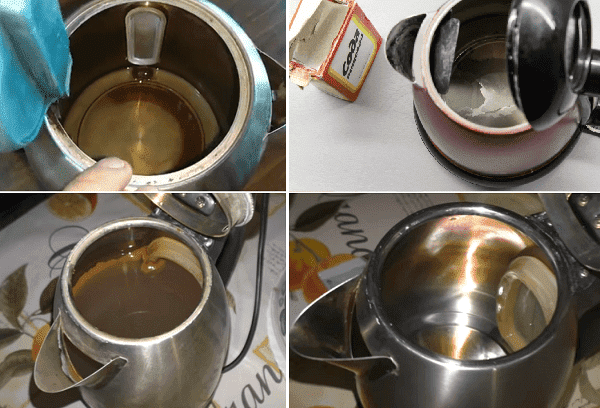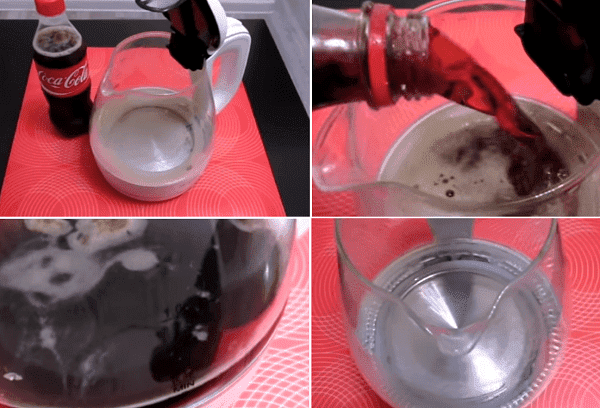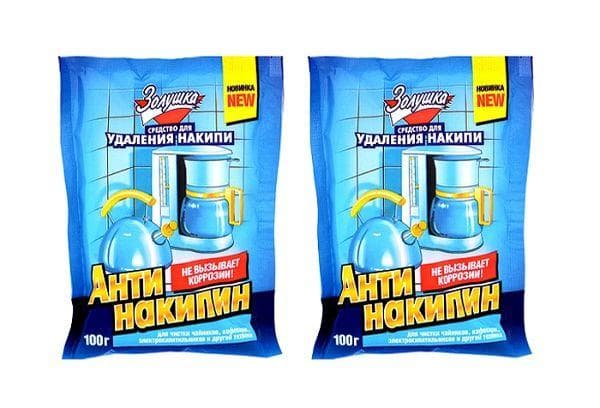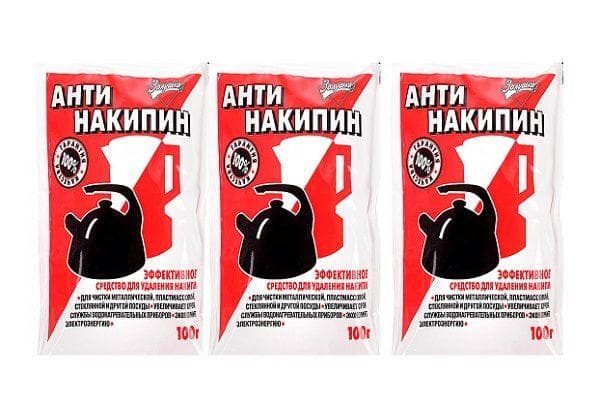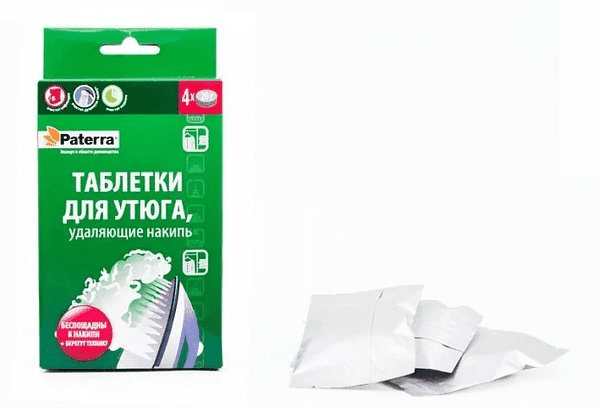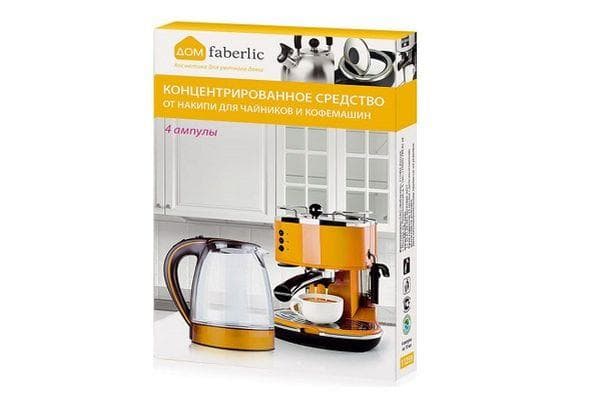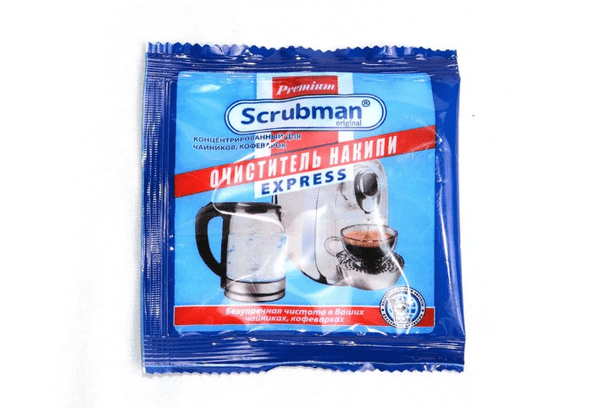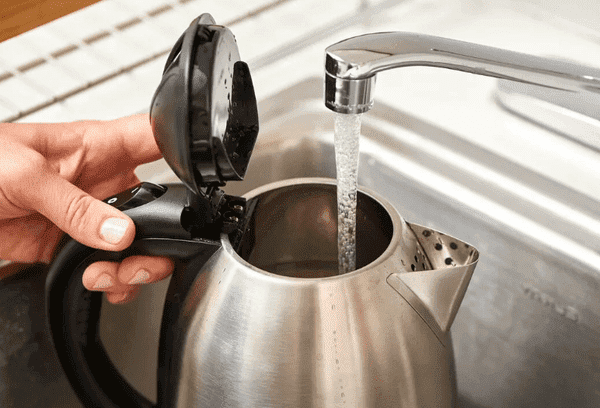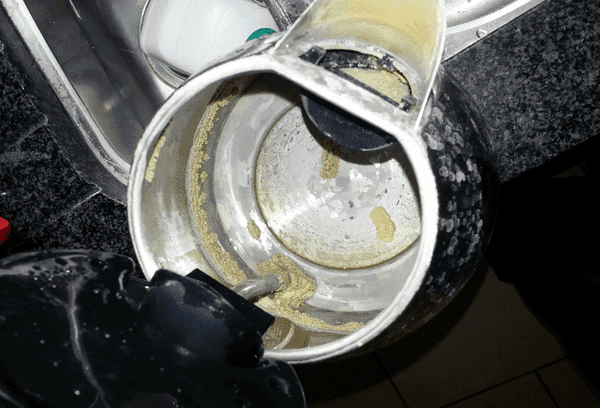How and how to remove scale from a kettle so that the inside shines
It doesn’t matter whether you drink tea or coffee, limescale in your mug will not add flavor to your drink. You need to descale the kettle. There are 5 store-bought and 5 home remedies that will help solve the problem in 15-30 minutes.
Content:
Scale: what is it and why does it appear?
Scale forms wherever raw water is heated: in washing machines, boilers, coffee machines, and, of course, in kettles. At first it looks like a whitish coating, which is difficult to clean off, and over time it completely turns to stone.
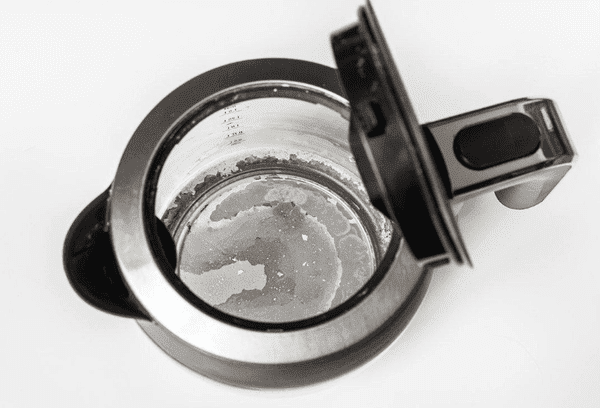
From a chemical point of view, scale is a mixture of calcium and magnesium carbonates with an admixture of calcium sulfate and iron metahydroxide.
Any drinking water contains a large amount of carbonates. Before heating, they are soluble and acidic.But under the influence of high temperatures they turn into medium CaCO3 and MgCO3, after which they precipitate. The more salts and various impurities in the water (the harder it is), the faster scale forms.
Interesting to know. Scale can be carbonate (grayish), or sulfate and silicate. If the water contains silicic acid compounds of calcium, magnesium, aluminum and iron, the inside of the kettle will be yellow.
What happens if you don't descale your kettle?
Scale is the same dirt. Leaving it in the kettle is, to say the least, unwise. It tends to flake off and get into tea or other drinks that we drink.
- Scale impairs the taste of drinks and is harmful to health. It used to be thought that particulate matter turned into kidney stones. In fact, the acid in the stomach breaks down the solid sediment. Is there any benefit to this? No. Scale is dead weight that travels a long way before leaving the body naturally.
- Scale does not conduct heat well. Water takes longer to boil. Accordingly, gas or electricity consumption increases. Within one day this is not very noticeable. What if you calculate the expense for the year?
- The walls of the devices (the heating element in the electric kettle), insulated with a layer of scale, overheat and as a result lose their strength. The kettle may leak and burn out.
Cleaning Products Review
If you try to descale a kettle mechanically, you will very quickly realize how ineffective it is. The plaque literally sticks to the walls. To get rid of it, you need to use emollients or solvents.
The choice of cleaning products for kettles is huge. You can use store-bought cleaners or resort to traditional methods.
Home Remedies
Most housewives continue to descale kettles the old fashioned way with citric acid and vinegar. These home remedies are on everyone's lips. They contain the most accessible acids - citric and acetic.
The acid reacts with the plaque, resulting in the formation of carbon dioxide, which destroys the scale. But there are other products that cost pennies and can be found in everyone’s kitchen.
Lemon acid
Lemon has a significant advantage over other home remedies for descaling - it does not smell.
The kettle is cleaned quietly and unnoticeably. Under the influence of citric acid, the boiled crust swells and falls off in pieces. Some of the scale dissolves in water. After boiling for a short time (high temperature speeds up the reaction), a gray-yellow liquid with pieces of plaque drains from the kettle, and its walls become clean.
How to clean a kettle with citric acid:
- Heat 1 liter of water.
- Dissolve 25 g of citric acid (2 tablespoons).
- Fill the kettle.
- Boil for 10 minutes to half an hour.
- Drain the water when it has cooled completely.
- Remove any remaining plaque with a stiff brush.
- Rinse the kettle with running water.
Vinegar
The second method involves using 9% table vinegar. It cleans kettle deposits as effectively as citric acid. There's just one problem:
Manufacturers of electric kettles prohibit the use of vinegar for descaling.
It is also worth considering that vinegar has a specific aroma, which only intensifies during descaling. It is important to carry out the procedure with the window open. Recipe:
- Prepare a solution of 2 parts water and 1 part 9% table vinegar. Usually take 3 glasses of water and 1.5 glasses of vinegar.
- Fill the kettle.
- Boil for 5-15 minutes.
- Leave the solution inside until it cools completely.
- Pour it out and rinse the kettle 3-5 times with clean water.
Soda
Baking soda works differently. It softens the plaque, after which it becomes easier to remove it mechanically. To descale your kettle:
- You need to pour 1 tbsp inside. spoon of soda.
- Fill it with water (to the scale level).
- Boil. Leave the heated solution for 15 minutes.
- Drain the water.
- Remove plaque with a metal sponge or a cloth with soda.
Cleaning
Not the most popular method, but, according to reviews, very effective. And completely free. You will need:
- clean potato peelings;
- lemon peel;
- apple peel.
You can use a little of everything, or choose just one. Lemon peels are considered the most effective.
- Fill the kettle a quarter full with peelings.
- Pour water to the top.
- Let's boil.
- Leave it overnight.
- We release the kettle.
- Wipe the inside with a cloth and rinse.
"Coca Cola"
There is an opinion that the advertised drink can remove rust. Scale, of course, is too tough for him too.
“Coca-Cola” can indeed help remove plaque, but only soft and fresh plaque.
Need to:
- Fill the kettle with Coca-Cola to the top of the deposit.
- Wait until the bubbles disappear.
- Boil with the lid open.
- Leave for half an hour.
- Drain the Cola and rinse the kettle with running water.
Store products
In recent years, many specialized products for cleaning teapots have appeared. They are a mixture of organic acids that are safe for health.
Kettle manufacturers insist on using store-bought descaling agents.
This is dictated by the fact that they are being tested. This means that they are guaranteed to cope with their task and do not damage the materials from which the device is made.In addition, store-bought products contain detailed dosage instructions on the packaging (unlike home recipes, which are not always passed on by word of mouth correctly and accurately).
"Antinakipin Extra" from TM "Cinderella"
This brand has the most positive reviews. “Antinakipin” from “Cinderella” costs 30-35 rubles, while only half of the composition is spent on one cleaning. It is a liquid concentrate.
To descale a kettle you need to:
- Pour 125 ml of cleaner into the device.
- Add 2 liters of water (cold!).
- Mix.
- Leave for 3 hours. There is no need to boil the solution.
- Pour out the product and wash the kettle with clean water and a sponge.
Anti-scale powder Cinderella (in red packaging)
The next descaler costs only 12 rubles. For this price we get 100 g of cleansing powder. The volume is enough for 2-3 cleanings of the kettle. Buying it is more profitable than using citric acid and vinegar.
To clean the kettle, pour 30-50 g of powder inside, pour in 2 liters of water, bring to a boil and leave for 5 minutes. If there is a lot of flight time, the waiting time can be increased to 2 hours.
Anti-scale tablets "Paterra"
This company has two types of scale cleaners: for irons and kettles. Despite its high cost, it is often purchased. Reviews about the product are only positive. The tablets are easy to use. You need to put 1 tablet in the kettle and pour 0.5 liters of water. Boil it and wait 5 minutes. After this, drain the solution with the removed scale and boil clean water 2-3 times (to remove chemical residues).
The cost of 4 tablets is 275 rubles.
Faberlic Dom descaler
A universal descaler that will help remove scale not only from the kettle, but also from the coffee maker, coffee machine, saucepan, iron and other appliances.It is a concentrate in ampoules. You need to pour the liquid from 1 ampoule into 1 liter of water, boil the kettle and wait 10 minutes. All scale will dissolve. For greater efficiency, the waiting time can be increased to 2 hours.
Cost – 99 rubles for 4 ampoules.
Scrubman scale remover
Another cheap remedy for descaling in teapots, costing 12-15 rubles. It is often used at home. The small packet of powder does not need to be dosed. All contents are poured into the kettle. Then 1.5 liters of water is poured. You need to boil the kettle and wait 10-15 minutes. After this, all plaque can be easily cleaned off.
Features of cleaning scale in different types of kettles
Different types of teapots have their own care characteristics. It is important that descaling does not contradict the general rules.
- Stainless. A stainless steel kettle can be cleaned with any of the above products. The material is not fussy and is quite easy to clean.
- Glass. Tempered glass teapots are considered resistant to caustic chemicals, scratches, and shocks. But we still advise you not to test the device for strength. Use classic methods. If the coating on the glass is fresh, you can remove it with a damp cloth.
- Enameled. It may happen that the scale falls off along with the enamel. To prevent this from happening, the enamel kettle must be cleaned on time. It is forbidden to beat off scale with a spoon or other hard object.
- Electric. In order not to damage the heating element, manufacturers of electric kettles strongly recommend cleaning scale only with store-bought products.
- Plastic. It is not recommended to overheat plastic electric kettles. There is no need to boil the solution over and over again. Just wrap the device with a towel.Also avoid using wire brushes, vinegar and harsh substances. Plastic scratches easily and absorbs odors and poisons.
Step-by-step instructions: how to descale a kettle
Cleaning a kettle from limescale is a simple procedure. You only need to do 5 steps:
- Step 1. Select a cleaning product and prepare a working solution. Use the recipes above or the instructions on the package (if using a store-bought cleaner).
- Step 2. Fill the kettle. The solution should cover the entire plaque. If not, just add water.
- Step 3. Let it boil. It is better to leave the lid open. Some products may bubble violently and spill out of the spout if the kettle is full. The solution must be boiled to speed up the reaction.
- Step 4. Wait from 10 minutes to 8 hours. The thicker the scale layer, the longer it takes for the solution to work. It works best at temperatures of 60-80 degrees. To maintain heat, the solution can be continued to boil or reheated from time to time.
- Step 5. Empty the kettle. Most of the scale will dissolve in the water, some grains will float at the bottom. Something may remain on the walls. You need to pour out the solution and clean them mechanically. This usually doesn't require much effort.
At the end, the clean kettle will only need to be rinsed. To calm yourself down, you can neutralize the acid with baking soda (alkali). You need to wash the walls with soda slurry. Rinse off the soda. All. The device will look like new.
If there is a lot of scale in the kettle...
No product can quickly deal with a thick layer of scale. It will take time for it all to dissolve or fall away. Necessary:
- Fill the kettle with a cleaning solution (vinegar, store-bought or other).
- Boil.
- Close the spout to prevent steam from escaping.
- Wrap with a towel.
- Leave for 3 hours.
- Boil the solution again and repeat steps 3-6.
- Drain the liquid, rinse the kettle and evaluate the cleaning result.
- If there is very little plaque left, you can remove it with an iron sponge, a stiff brush or a paste of soda.
- If there is strong scale, you need to prepare a fresh solution and repeat the procedure from the beginning.
The Internet is full of recipes that promise instant results. But if scale has been building up for months, none of them will work. We advise you not to waste time on dubious means and methods, but to be patient. In the future, preventive maintenance will eliminate lengthy cleanings.
How often to perform the procedure
Usually the procedure is carried out as needed. The presence of scale on the walls is determined visually and by touch:
- The inner walls become rough.
- A light yellow, gray or brown crust forms.
- When rinsing the kettle, the water comes out with crumbs.
- Glass walls become cloudy.
On average, scale forms in 2-3 weeks.
But with frequent use of the device, as well as boiling hard water, the process can speed up significantly. Therefore, it is correct to focus on your observations. Don't start the kettle. The resulting plaque quickly hardens, and the layer of scale thickens.
Preventing scale formation
If scale forms in the kettle too quickly, literally within a week, preventative measures are recommended. Simple steps will allow you to forget about cleaning for a month. Need to:
- Boil only bottled water.
- If tap water is used, it should be purified and softened using filters. Or at least stand for 2 hours (so that the impurities precipitate).
- Fill with fresh water, do not boil it twice.
- Wash the inside of the kettle with a cloth every day. Or at least rinse.
- Once a month, clean with citric acid, vinegar or another proven product.
Questions and answers
Why can’t an electric kettle be cleaned with vinegar?
The ban does not apply to all electric kettles, but only to old and very dirty ones. On such devices, the sealing ring near the heating element may come off and scale may penetrate deep inside. When cleaning with vinegar, there is a risk of leakage and damage to the electric kettle. You need to use more gentle products or reduce the concentration of vinegar in the cleaning solution by half.
Which water filter should I use to prevent scale from appearing again?
A reverse osmosis, flow-through or filter jug will help significantly slow down the appearance of scale in the kettle. The main thing is that the filter supports the function of water softening and effectively removes hardness salts from it. The following filters have proven themselves to be effective: “Aquaphor OSMO 50 version 5”, “Barrier EXPERT Standard”, “Brita Marella XL”, “Source Bio ER-5G”.
It's hard to imagine a kitchen without a kettle. Some people like regular ones, others like electric or glass ones. Regardless of the design, from time to time a deposit forms inside the device that needs to be cleaned.
Most often, solid deposits are removed using acid: citric, acetic, lactic, hexanediic, sulfamic, adipic. The first two can be found in the kitchen cabinet (vinegar and lemon). The rest are contained in special powders and concentrates for cleaning teapots. They are not very different in terms of efficiency. Housewives usually use the product that is currently at hand.
